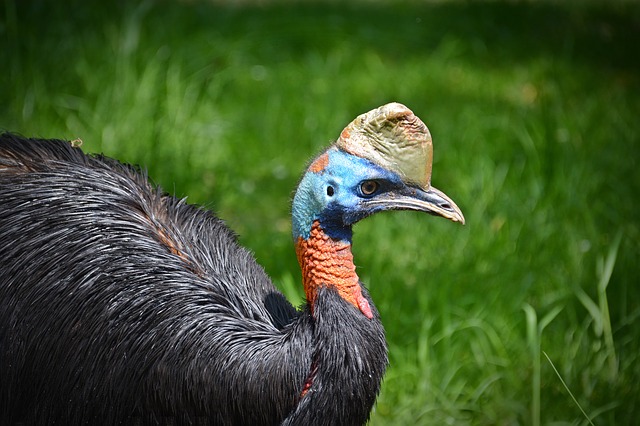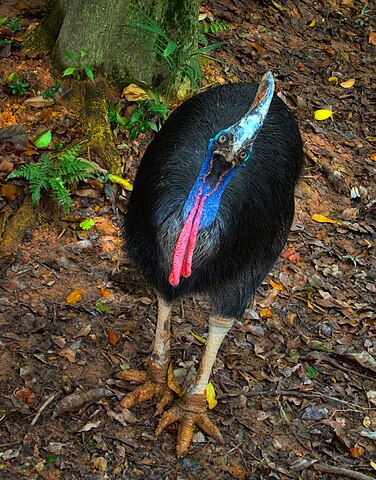 On April 13, a pet cassowary attacked and killed its owner, Marvin Hajos, a 75-year-old man who lived in Alachua County, Florida.
On April 13, a pet cassowary attacked and killed its owner, Marvin Hajos, a 75-year-old man who lived in Alachua County, Florida.
It appears that Hajos tripped and fell, and was then attacked by the bird. According to Jeff Taylor, the county’s Deputy Chief, the man sustained injuries probably a result of the bird’s lethal claws.
The bird at the center of the attack, along with 100 other exotic pets that Hajos owned, is being put up for auction as per the owner's last wishes. What exactly is a cassowary and why is it so dangerous?
Distinctive Features
Cassowaries (Casuarius casuarius) are large, solitary, flightless birds native to the tropical forests and wetlands of New Guinea, northeastern Australia, East Nusa Tenggara, and the Maluku Islands.
 Related to emus, another kind of flightless bird, cassowaries can reach a staggering height of 6 feet and can weigh up to a whopping 167 pounds, making them the second heaviest birds in the world after ostriches. Cassowaries are also extraordinarily fast, clocking speeds of up to 50 kilometers or 31 miles an hour. Their bodies are cloaked in a coat of fine, dense black feathers, while their necks and heads are bald—revealing a vivid swirl of blue, orange, red, and purple.
Related to emus, another kind of flightless bird, cassowaries can reach a staggering height of 6 feet and can weigh up to a whopping 167 pounds, making them the second heaviest birds in the world after ostriches. Cassowaries are also extraordinarily fast, clocking speeds of up to 50 kilometers or 31 miles an hour. Their bodies are cloaked in a coat of fine, dense black feathers, while their necks and heads are bald—revealing a vivid swirl of blue, orange, red, and purple.
A peculiar helmet, or casque, which consists of an inner spongy core and a sturdy outer layer of keratin, adorns their heads. No one knows why cassowaries have casques, but there are several theories. Casques could demonstrate a cassowary’s age or dominance, help it to pass through the jungle undergrowth unscathed, or enable it to make its signature sounds, which consist of a series of hisses, whistles, and other low-frequency noises.
A Frugivore!
 While cassowaries are solitary birds for most of the year, during breeding season—the time between June and October and coincidentally the time when fruit is most abundant—females become more tolerant towards males.
While cassowaries are solitary birds for most of the year, during breeding season—the time between June and October and coincidentally the time when fruit is most abundant—females become more tolerant towards males.
Once a female lays a clutch of green eggs, she departs, leaving the male to tend to the young. For about 60 days, the male incubates the eggs. Once they hatch, he guides and cares for the chicks until they are old enough to care for themselves, 9 to 10 months later.
Cassowaries are frugivores—in other words, they eat fruits. Due to the shortness of their digestive tract, cassowaries leave behind partially digested fruit seeds in their sweet-smelling droppings. These seeds end up taking root and sprouting. In a way, cassowaries are the jungle’s Johnny Appleseeds, “distributing” rainforest flora instead of apple trees. They are a vital part of the ecosystem, as many species of plants cannot sprout without having been digested by the birds.
What Makes Them Dangerous?
Cassowaries are often considered the most dangerous bird in the world. However, cassowaries are in truth peaceful creatures that will only attack when provoked, or when they associate humans with food—thus becoming aggressive. When this happens, chances of escape are slim.
Cassowaries’ three-toed feet are armed with 4-inch (10 cm), dagger-like claws, which become incredibly lethal when used in tandem with the birds’ kung-fu-worthy kick. And if that wasn’t frightening enough, cassowaries have two other skills to add to their suite of danger. The birds can jump vertically almost 7 feet (2 meters) from a standstill, and they can swim criminally well. In any case, it is best to avoid provoking cassowaries!
Sources: SanDiegozoo.org, BBC, National Geographic, NYTimes, Guardian, Washington Post







